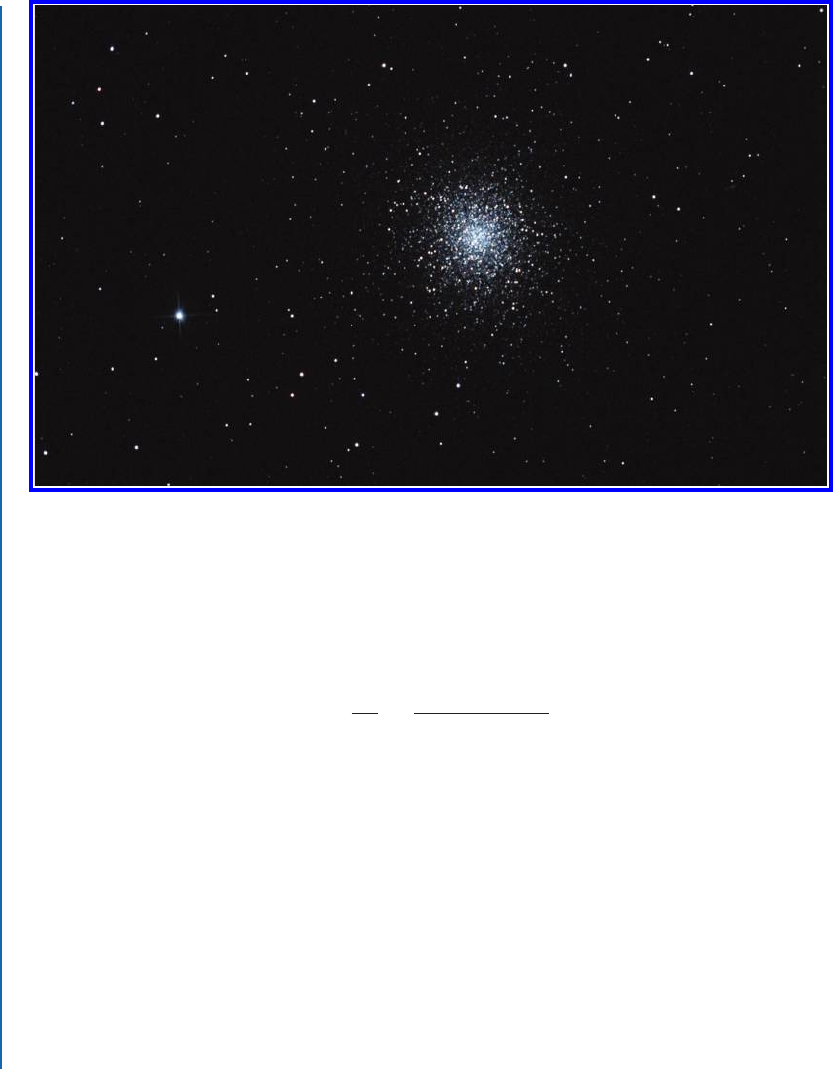
40 2. LOOKING OUTWARD
We can then convert our angular size of Betelgeuse to arcseconds simply by multiplying degrees
by 3600. is is somewhat better: .
2
/ D 0:0375. But that is still a very small number, and
so astronomers typically use the milliarcsecond (mas) for measurement of the angular diameter
of a star other than the Sun. To convert to milliarcseconds, we simply multiply arcseconds by
1000. And so the angular diameter of Betelgeuse is about 38 mas. If we include both of these
conversions into Equation (2.2), we have:
(mas) D
2:063 ˆ 10
8
d=D
: (2.4)
And it is not difficult to show that we can express this in terms of solar radius and distance in
parsecs as follows:
(mas) D 9:25
R=R
@
d (pc)
: (2.5)
Betelgeuse is a special star because its angular size is relatively large compared to other
stars—and yet it still appears only 38 mas across. It has, for example, about 35 times the angular
size of Proxima Centauri. Proxima Centauri is the closest star to Earth and yet it has an angular
diameter only a little larger than a milliarcsecond. Betelgeuse is over 200 times farther away, but
its enormous size more than makes up for its greater distance. Still, Betelgeuse is about as large
as a star can get, and it is also, for stars that large (which are quite rare), relatively nearby.
Consider, on the other hand, Sirius B; its distance and radius implies an angular size, from
Equation (2.5), of only D 0:003 mas. It’s companion Sirius A, on the other hand, is essentially
at the same distance but is 200 times bigger, and so it has a proportionally large angular diameter
of D 6:5 mas.
An angular size of 1 mas is equivalent to the apparent size of a dime, as seen from a
distance of about 3700 km—roughly the distance between New York, NY and Las Vegas, NV.
Is it possible to see such fine detail in even the world’s most powerful telescopes? e answer
is complicated, but resolving an angular size of only 1 mas is possible, but it is near the limit to
what can be done with the most advanced current techniques. And there are fewer than 20 stars
with an angular size greater than 1 mas as seen from Earth. All other stars are simply too far away,
and it means that—apart from less than two dozen exceptions—stars appear as only points of
light in even the biggest telescopes, and the angular size is not accurately measurable by direct
observation.
2.3.4 STAR CLUSTERS
Stars are not distributed randomly in space; they tend often to be grouped together into clusters.
Within a star cluster, stars are much closer to each other on average than they are outside of
clusters. But they are still very distant from each other compared to their sizes. Star clusters
play an important role in our understanding of stars. ey are, in effect, nature’s controlled

2.3. STARS 41
Figure 2.10: e open star cluster M 11, in the constellation Scutum. It is comprised of several
thousand stars, measures about 40 ly years across, and lies about 6200 ly from the Sun. Image
made from observations by Michael Briley, for Beaver et al. [2013].
experiments—locations in space where many stars formed out of the same cloud of gas and
dust, and all roughly at the same time. We will consider them often throughout e Big Picture.
Open Clusters
Open star clusters are also called galactic star clusters because they tend to be located along the
Milky Way. ey consist of dozens to many thousands of stars. A good example is M 11, lo-
cated in the constellation Scutum; it appears in a very small telescope as a dim cloud with an
angular diameter of about 25 arcmin. In a larger backyard telescope it can be seen as a scatter-
ing of hundreds of stars, while about three thousand can be detected with large telescopes. See
Figure 2.10 for an image made with a telescope at Kitt Peak National Observatory, as part of
the data set for Beaver et al. [2013].
is cluster is estimated to be about 6000 ly distant [Beaver et al., 2013]. We can use this
fact, in combination with its observed angular size, in order to determine its true size in space, as
described in Section 1.2. If we multiply the angular size of M 11 by its distance, we can calculate

42 2. LOOKING OUTWARD
Figure 2.11: e globular star cluster M 13 in the constellation Hercules. It is comprised of
several hundred thousand stars, measures about 130 ly across, and lies about 22,000 ly from the
Sun. (Image by Rawastrodata, CC BY-SA 3.0.)
its actual diameter in light years. We must first convert the 25 min of arc to radians:
D D
D
d (2.6)
D D 25
1
1
˝
60
1
0:01745 radians
1
˝
6000 ly: (2.7)
D D 44 ly (2.8)
And so this particular cluster extends across a volume of space some 44 ly in diameter. ere are
dozens of these open star clusters visible in our region of the Galaxy. M 11 is a particular rich
example, and contains considerably more stars than the average open cluster.
Globular Clusters
Figure 2.11 shows one of the most famous examples of a globular cluster, as imaged by a small
backyard telescope. ese clusters contain up to many hundreds of thousands of stars—in some
cases over one million. ey are roughly spherical in shape and are almost always much farther
away than the open clusters we see.
M 13 is over 22,000 ly away, and yet it appears almost as big in the sky as M11, even
though it is more than three times farther away. is means M 13 must be a few times larger
..................Content has been hidden....................
You can't read the all page of ebook, please click here login for view all page.
